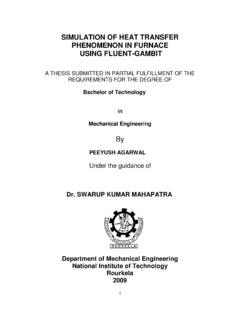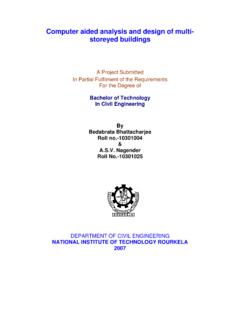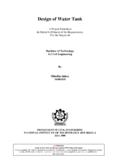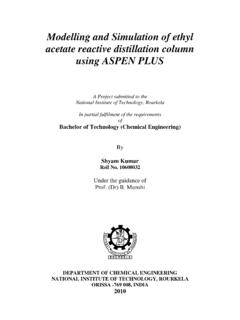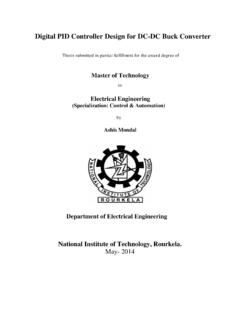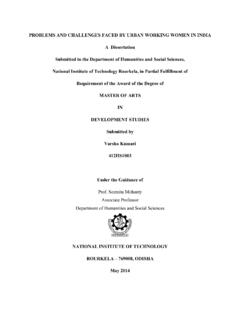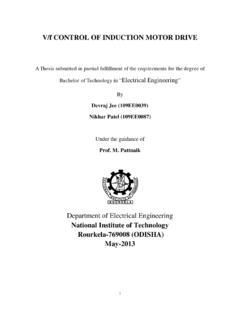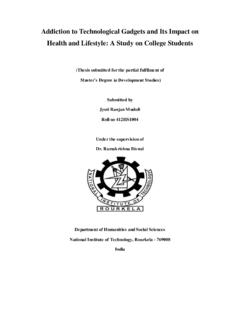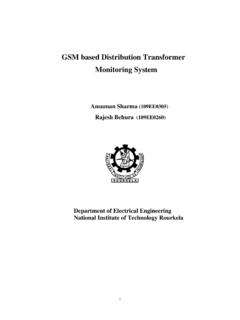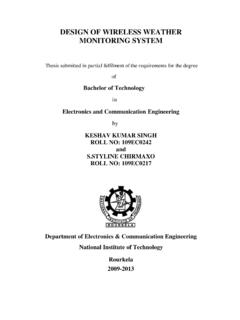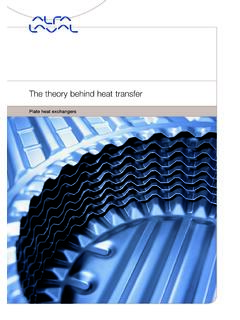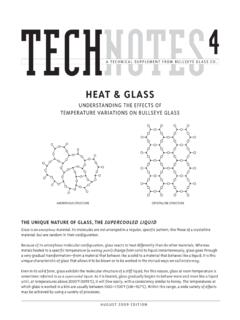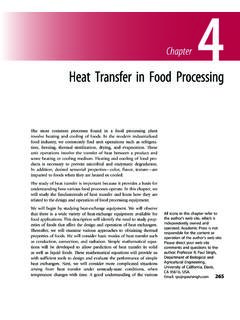Transcription of Heat Treatment of Low Carbon Steel - nitrkl.ac.in
1 1 A Project Report on heat Treatment OF LOW Carbon Steel In partial fulfillment of the requirements of Bachelor of Technology (Mechanical Engineering) Submitted By Sanjib kumar jaypuria (Roll ) Session: 2008-09 Department of Mechanical Engineering National Institute of Technology Rourkela-769008 2 A Project Report on heat Treatment OF LOW Carbon Steel In partial fulfillment of the requirements of Bachelor of Technology (Mechanical Engineering) Submitted By Sanjib kumar jaypuria (Roll ) Session: 2008-09 Under the guidance of Prof. (Dr.) S. K. Patel Department of Mechanical Engineering National Institute of Technology Rourkela-769008 3 National Institute of Technology Rourkela CERTIFICATE This is to certify that that the work in this thesis report entitled heat Treatment of low Carbon Steel submitted by Sanjib kumar jaypuria in partial fulfillment of the requirements for the degree of Bachelor of Technology in Mechanical Engineering Session 2008-2009 in the department of Mechanical Engineering, National Institute of Technology Rourkela, Rourkela is an authentic work carried out by him under my supervision and guidance.
2 Date: Prof. (Dr) S. K. Patel Department of Mechanical Engineering National Institute of Technology Rourkela - 769008 4 ACKNOWLEDGEMENT We deem it a privilege to have been the student of Mechanical Engineering stream in National Institute of Technology, ROURKELA. Our heartfelt thanks to Dr. S. K. Patel, my project guide who helped me to bring out this project in good manner with his precious suggestion and rich experience. We take this opportunity to express our sincere thanks to our project guide for cooperation in accomplishing this project a satisfactory conclusion.
3 Sanjib kumar jaypuria Roll no: 10503053 Mechanical Engineering National Institute of Technology Rourkela - 769008 5 CONTENTS Chapter 1 Chapter 2 LITERATURE Carbon LOW Carbon heat SURFACE FLAME AND INDUCTION 6 TYPES OF CARBURIZING GAS LIQUID PACK Chapter 3 Literature Chapter 4
4 EXPERIMENTAL SPECIMEN heat STUDY OF MECHANICAL HARDNESS ULTIMATE TENSILE STRENGTH 7 Chapter 5 Results and TABULATION FOR HARDNESS TABULATION FOR ULTIMATE TENSILE Chapter 6 8 ABSTRACT Low Carbon Steel is easily available and cheap having all material properties that are acceptable for many applications. heat Treatment on low Carbon Steel is to improve ductility, to improve toughness, strength, hardness and tensile strength and to relive internal stress developed in the material.
5 Here basically the experiment of harness and ultimate tensile strength is done to get idea about heat treated low Carbon Steel , which has extensive uses in all industrial and scientific fields. 9 Chapter 1 INTRODUCTION:- As we know there is a little bit of Steel in everybody life. Steel has many practical applications in every aspects of life. Steel with favorable properties are the best among the goods. The Steel is being divided as low Carbon Steel , high Carbon Steel , medium Carbon Steel , high Carbon Steel on the basis of Carbon content. Low Carbon Steel has Carbon content of to Low Carbon Steel is the most common form of Steel as it s provides material properties that are acceptable for many applications.
6 It is neither externally brittle nor ductile due to its lower Carbon content. It has lower tensile strength and malleable. Steel with low Carbon Steel has properties similar to iron. As the Carbon content increases, the metal becomes harder and stronger but less ductile and more difficult to weld. The process heat Treatment is carried out first by heating the metal and then cooling it in water, oil and brine water. The purpose of heat Treatment is to soften the metal, to change the grain size, to modify the structure of the material and relive the stress set up in the material. The various heat Treatment process are annealing, normalizing, hardening, austempering, mar tempering, tempering and surface hardening.
7 Case hardening is the process of hardening the surface of metal, often low Carbon Steel by infusing elements into the metal surface forming a hard, wear resistance skin but preserving a tough and ductile applied to gears, ball bearings, railway wheels. As my project concerned it is basically concentrate on carburizing which is a case hardening process. It is a process of adding Carbon to surface. These are done by exposing the part to Carbon rich atmosphere at the elevated temperature (near melting point) and allow diffusion to transfer the Carbon atoms into the Steel . This diffusion work on the principle of differential concentration. 10 But it is not easy to go through all the carburizing process like gas carburizing, vacuum carburizing, plasma carburizing and salt bath carburizing.
8 So we go through pack carburizing which can easily done in experimental setup. In this process the part that is to be carburized is placed in a Steel container, so that it is completely surrounded by granules of charcoal which is activated by barium carbonate. The carburizing process does not harden the Steel it only increases the Carbon content to some pre determined depth below the surface to a sufficient level to allow subsequent quench hardening. The most important heat treatments and their purposes are: Stress relieving - a low-temperature Treatment , to reduce or relieve Internal stresses remaining after casting Annealing - to improve ductility and toughness, to reduce hardness and to remove carbides Normalizing - to improve strength with some ductility Hardening and tempering - to increase hardness or to give improved Strength and higher proof stress ratio.
9 Austempering - to yield bainitic structures of high strength, with significant ductility and good wear resistance. Surface hardening - by induction, flame, or laser to produce a local wear resistant hard surface. 11 Chapter 2 2. Literature Review: Carbon Steel : Carbon Steel (plain Carbon Steel ) is Steel which contain main alloying element is Carbon . Here we find maximum up to Carbon and other alloying elements like copper, manganese, silicon. Most of the Steel produced now-a-days is plain Carbon Steel . It is divided into the following types depending upon the Carbon content. 1. Dead or mild Steel (up to Carbon ) 2. Low Carbon Steel ( Carbon ) 3.
10 Medium Carbon Steel ( Carbon ) 4. High Carbon Steel ( Carbon ) Steel with low Carbon content has properties similar to iron. As the Carbon content increases the metal becomes harder and stronger but less ductile and more difficult to weld. Higher Carbon content lowers the melting point and its temperature resistance Carbon content cannot alter yield strength of material. LOW Carbon Steel :- Low Carbon Steel has Carbon content of to Low Carbon Steel is the most common type of Steel as its price is relatively low while its provides material properties that are acceptable for many applications. It is neither externally brittle nor ductile due to its low Carbon content. It has lower tensile strength and malleable.
